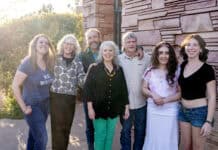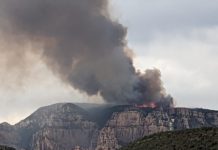You give yourself to the wall. You allow it to rub your hands raw, to leave your knees cut and bloodied and your muscles throbbing. But you let it happen because nothing is more satisfying than the feeling of finishing a difficult climb.
The allure of crags and chimney rocks is one of the many reasons climbers decide to visit Arizona.
But in the hyper-focus of thinking about the difficulty of the climb or how many pitches are needed, climbers sometimes forget to acknowledge how the formations got there to be begin with, or who originally inhabited the area.
In Sedona, pueblo dwellings perched on steep cliffs remind climbers that their rock climbing habits are hundreds of years old — that the ancient Sinagua tribe of the Verde Valley were climbers, too, scaling up the very same red rocks modern climbers dig their fingers into. In this way, the Verde Valley has acted as a time capsule preserving millions of years of history.
“The Verde Valley has been inhabited for over 10,000 years with various populations,” said Lucas Hoedl, an archaeologist with the Tuzigoot and Montezuma Castle national monuments. “The geology, water flow and natural resources available have always made it a desirable location.”
Hoedl said the Verde Valley limestone, which can be identified by its distinct white color, made constructing cliff dwellings ideal because of how soft it is. In fact, you can see a five-story cliff dwelling at Montezuma Castle.
Mountain formations like the Sierra Nevada, which are predominately granite, don’t change drastically. In contrast, the sandstone in Sedona is fragile. Layers upon layers of sedimentary rock tell their own geographical stories.
Basalt lava, Kaibab limestone, Toroweap sandstone, Coconino sandstone, hermit shale, Supai sandstone and Red Wall limestone make up the rock layers. Over the centuries, water and wind have eroded the rock faces, and that’s why the multicolored layers and unusual shapes such as spirals, hoodoos and buttes emerge.
In one place, the rock tells of a time when there were miles of endless sand dunes — deposits called sandstone. Another layer contains aquatic fossils, an era of a tropical sea life; rock called limestone. If you walk into the Red Rock Ranger Station, you can see displays that depict all seven layers found in the Verde Valley and learn how old each one is and what the environment was like during that era.
According to mountain project.com, 77 percent of climbing in the Sedona area is traditional climbing, aka TRAD climbing, while 16 percent is sport climbing. Unlike sport climbing, which leaves bolts permanently fixed into the wall, TRAD climbers place their own gear into natural rock features such as cracks or crevices and remove them.
If you are interested in spire climbing, check out the Mace in Sedona, but you have to do it on your own because U.S. National Parks regulations prohibit commercial guiding in Sedona. The Mace is off of State Route 179 and can be accessed by the Cathedral Rock trailhead off of Back O’Beyond Road.
But remember, sandstone is easily damaged when wet and crumbles in your hands. Holds can be deformed and whole routes altered; consequently, it is important to only climb during a dry period so that the rock is not damaged and history destroyed.
George Jozen with Coconino National Forest encourages people visiting Sedona or its current residents
to take advantage of the area, but also reminds people that certain areas are off limits.
“Creek Vista, overlooking Oak Creek — you’re not allowed to do any rock climbing there,” Jozen said. “It’s just too dangerous, and Midgley Bridge also is off limits, but you can climb in Wilson Canyon next to the bridge. We don’t want to encourage anybody who doesn’t have the skill set to attempt those climbs, and we want to make sure people are safe.”
He also encouraged people with questions about rock climbing to go to the Coconino National Forest website.
Next time you’re standing on top of a red butte, surveying the world, or find yourself admiring the aesthetic of a spire formation, remember you’re looking at a landscape with a complex past in its most unadulterated form.
Samira George can be reached at 282-7795 ext. 126, or email sgeorge@larsonnewspapers.com


















